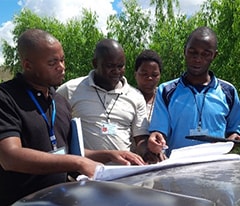
New PHIA Survey Data Show Critical Progress Towards Global HIV Targets

New findings released today by the U.S. President’s Emergency Plan for AIDS Relief (PEPFAR), CDC and ICAP at Columbia University from the Population-based HIV Impact Assessments (PHIA) show that country, global, and US-supported HIV efforts have made critical progress toward achieving an AIDS-free generation.
Combining household visits with key questions and cutting-edge technologies, PHIA surveys are the first to directly measure all of the above: national HIV incidence, pediatric HIV prevalence, and HIV viral load suppression in some of the countries most affected by the HIV epidemic. Under the leadership of each country’s Ministry of Health, survey teams travel door to door to implement these surveys in 13 PEPFAR-supported countries mostly in Sub-Saharan Africa – the region that is most severely impacted by HIV. These countries include: Cameroon, Cote d’Ivoire, Ethiopia, Haiti, Kenya, Lesotho, Namibia, Malawi, Swaziland, Tanzania, Uganda, Zambia, and Zimbabwe. PHIA survey results from each country will become available as they’re completed over the next few years.
The results of new Population HIV Impact Assessments in Malawi, Zambia, and Zimbabwe suggest these countries are making tremendous progress towards achieving epidemic control: confirming estimated reductions in incidence from 2003 to 2015, measuring high population viral load suppression (67 percent of adults living with HIV in Malawi are virally suppressed, compared to 60 percent of adults living with HIV in Zimbabwe, and 59 percent of adults living with HIV in Zambia), and demonstrating that persons who report knowing they are HIV-positive are likely to be accessing treatment with successful viral load suppression.
The new findings also validate what have only previously been predicted in models: that global HIV efforts are accelerating country progress toward achieving epidemic control. They also shine a light on the specific populations that need greater attention and services to meet their needs. Specifically, they show us that more attention is needed to reach more young people with HIV, especially adolescent girls and young women, to help them stay on their treatments. More work is also needed to reach adult men with HIV testing since they are less likely than women to know their status.
In collaboration with partners, CDC’s Division of Global HIV & TB is playing a key role in designing and implementing the PHIA surveys -- lending expertise in epidemiology, laboratory science, program services, and workforce training. The surveys will provide critical information on the state of the HIV epidemic and help shape future HIV policies and programs.
Statement from Shannon Hader, MD, MPH, Director of CDC’s Division of Global HIV & TB
“The Population-based HIV Impact Assessments are a powerful new tool in that they paint the clearest picture to date of the HIV epidemic in several sub-Saharan countries. New findings from Malawi, Zambia, and Zimbabwe validate what we have only been able to previously predict in models – that our global efforts are having a measurable impact in countries with some of the most severe HIV epidemics.
These data suggest that, in the areas surveyed, we are making encouraging progress towards global targets for people on HIV treatment and virally suppressed.
At CDC, saving lives through public health impact is our core mission. We believe data is a foundation that helps us do that more effectively. These surveys allow us to harness the power of data for greater insights on where to focus our collective efforts and resources going forward. This ultimately helps save more lives.
The Population-based HIV Impact Assessments would not have been possible without the leadership and support from the country governments and ministries of health, funding and support from the U.S. President’s Emergency Plan for AIDS Relief, technical expertise and implementation supports from ICAP at Columbia University and our CDC experts on the ground in collaboration with local partners.”
Stories from the Field
CDC is playing a key role in providing technical and scientific expertise to country partners in creating and implementing the PHIA surveys to mark progress and inform next steps to save more lives. Following are brief profiles that highlight different approaches countries are taking to bring PHIA surveys to communities nationwide:

Technology yields impressive results in Malawi’s Population-Based HIV Impact Assessment
Tablet technology was a critical part of the Malawi Population-Based HIV Impact Assessment (MPHIA)project that conducted national, HIV household-based surveys of adults, adolescents and children. Using 160 tablets, in three languages, the national data collection effort ran from November 2015 to August 2016. Trained survey staff used computer assisted personal interviews on android-based tablets to interview adults and children from approximately 15,000 randomly selected households with pre-programmed tablets and portable blood testing equipment. The use of the portable technology that automatically stored content reduced the amount of time required for data cleaning from six months for paper-based data to just one month for the tablets. This boost in efficiency enabled the teams to reach more people. In over 11,000 households, surveyors spoke to over 19,800 adults about HIV testing and whether or not they knew their HIV status. Participants who self-reported positive were asked whether or not they were currently taking antiretroviral medications. In addition, survey teams performed viral load testing on all participants who were found to be HIV positive. These survey efforts are now giving Malawi a national-level view of HIV incidence, pediatric HIV prevalence, viral load suppression, and use of services across its population to better help the country make critical progress towards achieving an AIDS-free generation.
The Malawi population-based HIV impact assessment was led by the Government of Malawi through the Ministry of Health, conducted with funding from the U.S. President’s Emergency Plan for AIDS Relief (PEPFAR) and technical assistance through the U.S. Centers for Disease Control and Prevention (CDC). The survey was implemented by ICAP at Columbia University in collaboration with local partners.

Singing the praises of Zimbabwe
Zimbabwe was the first country to launch the population-based HIV impact assessment (PHIA). The PHIA is the first household survey in Zimbabwe to directly measure national HIV incidence, pediatric HIV prevalence, and viral load suppression, and use of services. The survey provides the sharpest picture to date of the HIV epidemic in the country. In Zimbabwe, survey teams visited approximately 15,000 households across the country to interview consenting participants and provide them with HIV counseling and testing, as well as syphilis testing.
In Zimbabwe, the song, “Knock, Knock, Knock,” was recorded by leading Zimbabwean poets and musicians to share the importance of the PHIA surveys with communities across the country. The song played frequently on the radio and reached cities and rural areas helping to inform communities about the house to house surveys that were happening across the country. “The ZIMPHIA song is a great example of the creative, collaborative approaches to public health promotion that CDC likes to support,” said Beth Tippett Barr, CDC Country Director, Zimbabwe. “It reflects a strong engagement with our national partners.” The success of the effort was evidenced by the nearly 12,000 people who participated in the survey from 2015-2016. Zimbabwe’s creativity and success to date in effectively responding to the HIV epidemic is a model for others working to pave the way toward an AIDS-free generation.
The Zimbabwe population-based HIV impact assessment was led by the Government of Zimbabwe through the Ministry of Health, conducted with funding from the U.S. President’s Emergency Plan for AIDS Relief (PEPFAR) and technical assistance through the U.S. Centers for Disease Control and Prevention (CDC). The survey was implemented by ICAP at Columbia University in collaboration with local partners. Adapted from the Columbia University Mailman School of Public Health story.

Supporting the next generation of HIV surveillance in Zambia
CDC began work in Zambia in 2000. The country had previously implemented many strategies to address the HIV epidemic, but there was not enough quality data to guide national decision-making and planning. For almost a decade, CDC has worked with the Zambian government and multilateral donors to improve disease surveillance throughout the country. CDC’s earliest involvement was through surveillance which focused on sentinel surveillance and AIDS cases.
Most recently, CDC has been providing technical support to the Government of the Republic of Zambia to establish the next generation of disease surveillance. These surveys focus on improving and expanding existing surveillance methods and include bio behavioral, HIV-case, sexually transmitted infection (STI) and morbidity and mortality surveillance. One example of these surveys is the Zambia population-based HIV Impact Assessment (ZAMPHIA) survey, which began in March 2016 and concluded in August 2016. Survey teams visited approximately 15,000 households across Zambia to interview people and provide HIV counseling and testing, as well as syphilis and hepatitis B testing. ZAMPHIA survey teams collected blood samples and performed rapid HIV tests and point-of-care CD4 tests. Participants then received test results within minutes, in the privacy of their homes. Findings from the survey will not only be used to better understand the Zambia HIV epidemic, but will help shape future HIV programs and policies to confront the epidemic.
CDC Zambia is excited about the potential of working alongside our partners to bring together these surveillance strategies to better serve the needs of the country and address the HIV epidemic. The Zambia population-based HIV impact assessment was led by the Government of Zambia through the Ministry of Health, conducted with funding from the U.S. President’s Emergency Plan for AIDS Relief (PEPFAR) and technical assistance through the U.S. Centers for Disease Control and Prevention (CDC). The survey was implemented by ICAP at Columbia University in collaboration with local partners.
Resources
PHIA surveys are one part of CDC’s broader efforts, through PEPFAR, to ensure people with HIV know their status, are linked to treatment, and are virally suppressed – with the ultimate goal of preventing new infections and saving more lives. To learn more about how CDC is supporting countries in their quest to reach the global 90-90-90 targets, CDC’s Division of Global HIV &TB offers the following additional resources:
| On the Calendar |
| December 1: World AIDS Day December 3: International Day of Persons with Disabilities December 5: International Volunteer Day December 10: Human Rights Day December 18: International Migrants Day |






















.png)











No hay comentarios:
Publicar un comentario